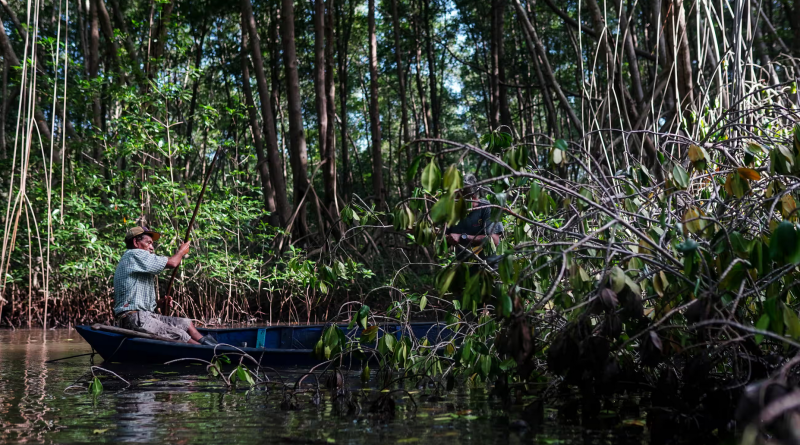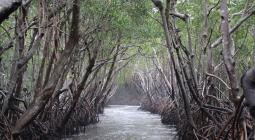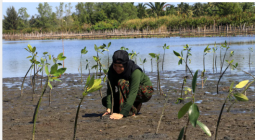The vanishing mangroves of El Salvador: ‘All our efforts may only slow the destruction’

Alvaro Avilez, 69, prepares to clear a tree from a mangrove channel. Photograph: Camilo Freedman/The Guardian
Along El Salvador’s western coast lies a 10,000-hectare (25,000-acre) emerald oasis, in stark contrast to the rest of the country’s largely deforested landscape. This lush forest, just a few miles from the Guatemalan border, teems with diverse wildlife – from crocodiles and crabs to fish darting through seemingly endless mangroves.
More than a biodiversity haven, Barra de Santiago serves as a crucial carbon sink in a region battling deforestation, and a natural shield for a country exposed to climate crisis-induced tropical storms and escalating sea levels. It is also home to thousands of people, whose lives are intricately tied to the resources provided by land and sea.
However, this critical natural asset in Central America is in danger due to the effects of the climate crisis, rapid urbanisation, cattle grazing, extensive deforestation from the sugarcane industry, and increasing demand for timber in the country.
Since 1950, El Salvador has lost more than 60% of its mangrove forest. In 1982, an earthquake and tropical storm that hit the coastal region partially destroyed the Barra de Santiago mangrove, accelerating the environmental devastation.
The climate crisis remains a threat to the mangrove forest, as stronger storms are causing trees to fall, and the increase in temperatures is putting this marine life sanctuary at risk.
“We are monitoring the physical and chemical parameters of the water monthly, and over the last four years, we have seen a drastic increase in the water temperature – up to 4 degrees – during the dry season, while the rainy season is bringing stronger storms adding to a rise in the death of species,” says Marcela Díaz, a biologist from the Salvadoran Ecological Unit who works in protected areas including Barra de Santiago.
During a tropical storm that hit El Salvador in June, the rainfall was so intense that locals had to go out to save Ucides occidentalis crabs. “The rainwater took the crabs out of their caves and swept them to the shore, so we collected approximately 80,000 of them to bring them back to safety, as people were taking them by the thousands,” says Juan Antonio, 52, a Barra de Santiago resident and a member of the Local Sustainable Use Plan (Plas) group, an environmental community group.
New urban developments have also been threatening the saltwater forest. Despite allegations of human rights abuses, the ongoing state of emergency in El Salvador – an iron-fist policy launched as a war on gangs by the hardline Nayib Bukele administration in March 2022 – has given a sense of security to those seeking to invest in real estate, leading to a boom in the housing market.
One such example is Oasis, a $5m (£3.8m) housing complex being built by the LAR Development Group. Signs advertising the luxury properties have already appeared at the Barra de Santiago entrance.
The Barra de Santiago is bordered on one side by mangroves with the ocean on the other; the project will be the first to build houses on the mangrove side. The enclave is less than a kilometre wide, and even water and waste management from existing houses on the ocean side can become a critical problem, according to experts.
“It would be necessary to deforest to carry out a project like this. In addition, greywaters and swimming pools don’t usually have good treatment systems and end up in or near the mangroves, affecting the quality of the water and the species that live there,” says Díaz.
The Guardian asked the company for an interview or comment but received no reply.
As well as authorising new real estate developments in the area, the government is pushing ahead with phase two of its Surf City project, which will build roads and tourist infrastructure around the east beaches of El Salvador where another large portion of its mangroves are located.
“As long as development goes hand in hand with the destruction, through the construction of hotels and housing complexes, the future will be discouraging,” says Díaz. “Just the Pacific Airport [one of Bukele’s key campaign promises from his first time running for office] will mean a big loss in the country’s remaining mangrove.”
The government of El Salvador did not respond to requests for an interview or comment.
Yet the mangrove forest isn’t the only thing at risk from the growing number of exclusive properties. The local economy has been reorganised around the tourism industry to cater for the influx of people, with positive but also adverse effects – including growing inequality.
“Most people now can only hope to get a job working for one of the wealthy families, taking care of their beach houses,” says Antonio. “They are privatising the whole of Barra de Santiago and destroying the resources we depend on.”
Local people have few options, and are increasingly reliant on jobs in small hostels and restaurants, or construction and agriculture. Luis Quintanilla, a technical officer at the Association of Women of the Barra de Santiago, a mangrove conservation group, says: “This is where some of the country’s richest people coexist with the poorest ones. Almost every house on the beach side is owned by a wealthy family.”
An alternative has been to work in environmental preservation. Since 2012, local women and fishers have launched initiatives to rehabilitate the mangrove ecosystem in collaboration with international partners. One such initiative is run by the Plas group, and aims to improve the livelihoods of its members through self-governance and the sustainable management of the forest.
Juan Antonio works with Plas to protect the forest. Workers get paid a small wage and receive permits, which allow lumber sellers to cut a four-metre log once a year, which can be sold for $50 (£38) in the local market. But making a living this way is hard. The legal minimum wage in El Salvador is $365 a month.
“Most older people here do this to make $50 a year by selling lumber, while younger people live off of crab-catching and can make around a minimum wage every month,” Antonio says, pushing a small canoe through a channel in the mangrove.
Domingo Reinosa, 63, is another member of Plas trying to adapt to new – and more restrictive – regulations imposed by the Ministry of Environment and Natural Resources on mangrove exploitation. “We get a pass to extract lumber as a reward; in exchange, we clean the channels and do restoration and desilting activities,” he says.
Alvaro Aviles, 69, increases his fishery income by helping to conserve the mangroves. In return, he also receives official permission to harvest timber legally. “We don’t lack people to work [in conservation], as young people also need to survive,” says Aviles. “People like my son want to earn a little more and also help preserve the forest.”
Since 2022, mangrove areas in El Salvador have been part of a Unesco-led restoration project, which will invest until 2025 in actions to restore and conserve mangroves in Colombia, Cuba, Ecuador, Mexico, Panama and Peru.
The project aims to empower local communities and young people through training and education, raising awareness about the environmental importance of mangroves. It includes the development of educational toolkits and support for the OceanTeacher Global Academy, an internet-based training platform.
Local people, however, hold out little hope of recovering degraded mangrove forests in El Salvador. “The new real estate developments, the use of pesticides and especially the sugarcane industry makes it hard to think that we could return to a healthy forest,” says Díaz. “All of our efforts will probably only slow down the destruction.”





